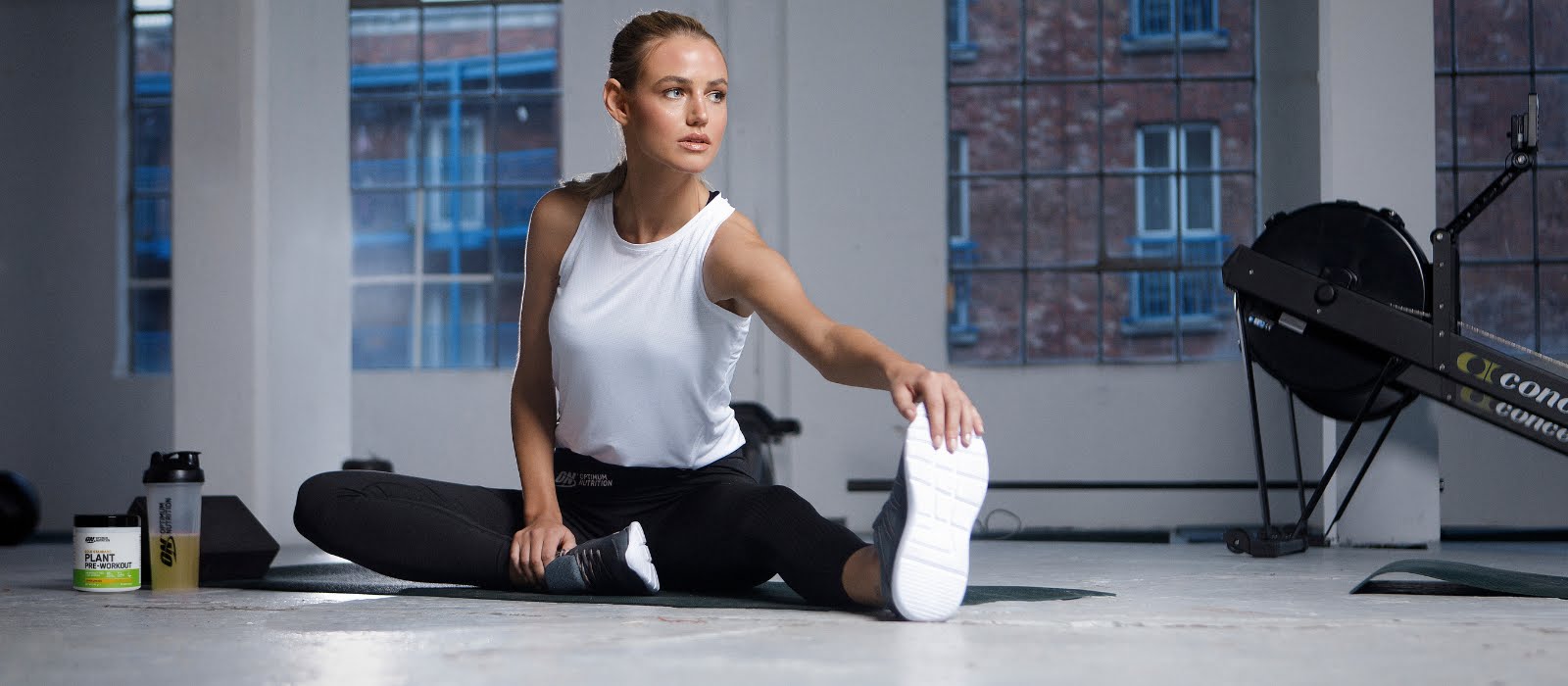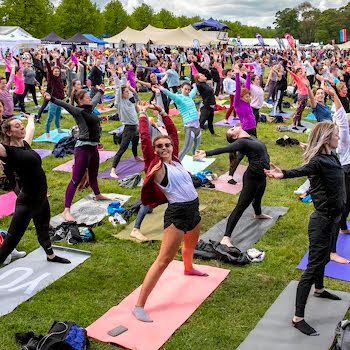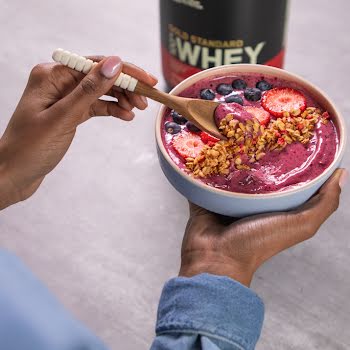
Optimum protein intake: how much is enough and how to get it?


We put the Optimum Nutrition Protein Calculator through its paces with some quite surprising results.
It was really interesting to sit down with Optimum Nutrition nutritionist Mark Evans and talk all things protein. In order to help people to better understand how much protein they need in their daily diet, the brand has introduced a super easy to use Optimum Nutrition Protein Calculator – and you may be surprised to learn that your recommended amount of protein is considerably higher than you thought.
Mark explains that while the current recommended daily guideline is only 0.8g protein per kilogram of body weight, most of us can, in fact, benefit from a higher amount of protein in our daily diet. Mark explains that protein is not only important for those looking to improve performance in sports and fitness – it provides our body with building blocks called amino acids for muscle, bone, hair, nails, and even hormone health.
For women in midlife, it is particularly important to help ward off age-related loss of muscle and bone mass. It always comes as a bit of a shock to learn that we lose anything from 3% to 8% of our muscle mass per decade after we turn 30! So it really is important that we try to ensure that we’re looking after our muscle and bone health as we age by eating a well-balanced and varied diet and having a structured exercise routine.

Food first
Mark is quick to confirm that a food-first protein approach is absolutely the way to go. In other words you should always be striving to achieve your daily protein intake through a healthy, balanced diet, replete with plenty of plant and lean protein sources, which can then be supplemented with the likes of protein powders, but they are only designed to be a helpful supplement to help you hit your daily protein targets rather than a food replacement.
How does the protein calculator work?
The way the Optimum Nutrition Protein Calculator calculates a recommended daily protein intake is based primarily on your weight and what your goals are – for example, are you looking to bulk up, or trying to reduce body fat but retain muscle?
If you are looking to bulk up, it will be 2g of protein per kg of body weight per day, if you’re looking to build muscle, it’s 1.8g per kg, if you’re looking to maintain current body weight, it’s 1.6g per kg and if you’re looking to lose body fat but hold onto muscle, it recommends 2g per kg.
It will also suggest a daily calorie (incorporating age), carbohydrate and fat recommendation, as well as provide an example of how to meet your protein goals through foods and supplements, giving you the tools you need for a well-balanced diet.
Example: 70kg Bodyweight: RDA = 56g protein per day; bulk up = 140g protein; build muscle and lose fat = 140g protein per day; build muscle = 126g protein per day; maintain weight = 112g protein per day.
Timing your protein intake
When we exercise, we create micro-damage to our muscle fibres and protein is the essential ingredient that helps our body repair and indeed grow and strengthen these stressed muscle fibres. And this is where the good stuff happens. When we asked Mark whether it was important that we have our protein intake within the 30-minute window post-exercise, he replied that it was more important to make sure you’re hitting your overall daily amount, and not to worry too much about the exact timing of your protein intake.
Mark would recommend that you spread your protein intake throughout the day as much as you can. So, for example, if you are a fairly routine three meals a day person and your daily recommended intake is 120g, ideally you should aim to have 40g per meal. On the Optimum Nutrition website you’ll find a very useful infographic chart which lists a variety of protein-rich foods, such as eggs, chicken breast, etc., and highlights how much protein is in each. It can be a really useful exercise to keep a food diary over the course of a week and then do some calculations to see how much protein you are currently getting from your food intake and how this matches with your recommended amount.
Out of curiosity, we gathered a few members of team IMAGE to do just that…
Lizzie Gore-Grimes, age 49
Goal: Looking to lose body fat but hold on to muscle. I work out 4-5 times a week, including a good mix of cardio and weights. Using the Optimum Nutrition Protein Calculator it recommends an intake of 138g.
Although this was my first time using the protein calculator, I feel like I’ve been on the protein awareness journey for some months now. As I signed up with a dietician, Aoife Quinn, at my gym (Fianna Athletic Club) a few months ago in an attempt to improve my eating habits. With my 50s just around the corner, I am particularly keen to start taking better care of my bone, muscle and hormonal health.
Everything Mark says above echoes what my dietician Aoife has been encouraging me with. For the last few months, I have been adopting the “plate method” (where half of your plate at every meal is made up of non-starchy veg, with one-quarter high-fibre carb and one-quarter lean protein). I was very much encouraged by Aoife to have protein at every meal and to ensure snacks were also protein-rich. Her approach is also very much food-first, but in order to get my numbers up I have been supplementing with a whey protein smoothie once a day and finding that a huge help.
After a good bit of experimenting, I have settled on a favourite routine: 1-2 eggs for breakfast with fresh spinach or sliced cucumber and a slice of McCambridge’s brown soda bread; salad for lunch with lots of crunchy veg and some form of oily fish (choosing between tuna, smoked salmon, sardines, mackerel etc). Donegal brand Shines do really superb quality tuna and tinned fish that you can have in your cupboard to make a super quick and easy healthy lunch). Midweek dinner, for me, is most often roast chicken, salmon, red lentil dahl, or Asian-inspired turkey mince stir-fry – all served with lots of tasty veg to bulk it out. I make a smoothie with coconut water, spinach, mixed berries, mixed seeds and 30g whey protein powder at 4pm which I find is a huge help to ensure I am not hungry in between meals and am hitting that daily protein target.
Megan Burns, age 30
Goal: Aiming to build muscle. I play sport three times a week, running and yoga where I can, as well as walking for at least an hour each day. Using the Optimum Nutrition Protein Calculator it recommends an intake of 103g.
As someone who plays sports a few times a week and is generally active, I know in theory that protein is important, but I’ve never thought too much about the specific amount I should be eating. And while I make an effort to eat some protein at each meal, having noticed the difference it makes in my energy and hunger levels, speaking with Mark Evans, nutritionist at Optimum Nutrition, I realised how I need to make much more of an effort to hit the correct amount.
While we might think of protein as being important for muscles, and it is, what I wasn’t as aware of is how protein is key to the healthy functioning of every aspect of your body. It’s essential for all the tissues in our body, while our hormones are proteins, so we need adequate amounts to produce them correctly. Recent research is also pointing to protein’s importance for everything from bone to gut health.
Trying out the protein calculator, I was very surprised to be recommended to eat 103g of protein a day. I think on average I usually hit only around 60% of that number, so it will take some adjustments from me to hit this target, but I’m looking forward to the challenge!
I’m thinking of ways to incorporate more protein into what I already eat. Some things I’ll be trying are keeping roasted chickpeas or edamame on hand for a crunchy snack, adding seeds as a topping to all kinds of dishes, eating more yoghurt, whether as a snack or adding a dollop on top of a dish (I love to add salt, lime juice and zest for a quick dip). Basically, when planning meals, I’m now taking a minute to work out if there’s enough protein in what I’m making, and if not, thinking about what would be easy to add in.
For example, I often eat eggs for lunch, but as Mark pointed out, two eggs alone don’t contain enough protein to hit the amount I need to eat each meal – they contain only about 12g of protein, when I’m aiming for around 30g. I could add an extra egg, or add something like hummus or cheese to the meal to take its protein content up. Other examples include stirring beans or lentils into pasta sauces and stews, cooking rice in chicken stock to up its protein content or swapping it for a higher-protein grain such as quinoa, and making an effort to experiment with other protein-rich options beyond my lunchtime eggs, such as tofu and tinned fish.
Breakfast is another meal where I don’t usually hit that 30g target. Although I incorporate a seed mix into my porridge, adding whey powder too would be an easy way to give the meal an extra protein boost.
Meghan Killalea, age 26
Goal: Aiming to lose body fat and maintain muscle. I attend a weekly reformer pilates class and go for a long walk every day. Using the Optimum Nutrition Protein Calculator it recommends an intake of 54-82g of protein per day.
As someone who lives with food intolerances, I put a huge emphasis on my nutrition. When I was 17 I discovered that I was intolerant to gluten, dairy, and eggs. This meant that I had to delve into the world of gut-friendly ingredients to make sure I was getting the right balance of nutrients in my diet to have the energy to get through the day.
Admittedly, nearly 10 years later, I’m still learning a lot about how our bodies work and what you should fuel them with. Something that is new to me is just how important protein is in increasing your daily energy, and after speaking to Mark Evans, nutritionist at Optimum Nutrition, I’ve realised that it’s not as daunting a goal as social media fitness fiends would allow you to believe.
After trying the protein calculator, I was interested to see that it recommended a protein intake of 54-82g per day. However, the part that I was most interested in when chatting to Mark was that he recommended having a source of protein with each meal, something I currently don’t do.
It was very refreshing to see that within the foods suggested by the protein calculator, there were options including lentils, tofu, and many more. Usually, eggs are the go-to for your protein goals, particularly for breakfast, so it’s great to know that there are many options for those of us with food intolerances.
Going forward, my goal will be to incorporate protein into every meal. For example, having a protein-packed smoothie bowl or avocado toast for breakfast followed by a lunch packed full of lentils, chicken breasts, or tofu. I’m excited to see if these conscious additions to my diet have a positive impact on my overall energy levels.
Olga Gordeychuk, age 38
Goal: Aiming to lose body fat and maintain muscle. I am currently training for HYROX and attend yoga classes weekly. Using the Optimum Nutrition Protein Calculator it recommends an intake of 124g of protein per day.
I’m training for HYROX and aim to hit 124g of protein a day (thanks, Optimum Nutrition Protein Calculator!). Why so much protein? Especially for us women, it’s crucial — not just for maintaining muscle as we age but also for supporting our metabolism, keeping hunger in check, and boosting recovery.
Fitness has always been a passion of mine – whether it’s hiking, running, martial arts, or swimming, I’m always moving. But in the past few years, DEKA and HYROX (a combo of functional exercises and running) have really hooked me in. My coach Dena Hogan keeps me on track, and one thing she has taught me is that when it comes to training, nutrition is just as important.
Talking with Mark Evans, a nutritionist at Optimum Nutrition, really drilled it home for me – getting enough protein isn’t optional – it’s key for performance and muscle recovery. Plus, when I’m hitting those macros (protein, fats, carbs), my energy is better, and I bounce back faster.
I tried to track my daily protein intake by tracking all my meals, and I was surprised by how difficult it is to hit that daily protein goal (and how frustrating tracking can get!). Since then, I have tried to include some form of protein with every meal.
Protein overnight oats (with a scoop of whey), Greek yoghurt, eggs or cottage cheese with smoked salmon are some of my favourite breakfasts. For lunch, I opt for lentil dahl, tacos, fajitas, or good ol’ leftovers. My evening meal is an important part of my day, as the family comes together around the table. I enjoy good quality steak, chicken or prawn curry, stir fry, or on colder nights, shepherd’s pie or Borscht (a nod to my roots). I take protein shakes after workouts.
And for those sweet cravings, I’ve got my secret weapon: protein baking. Whether it’s cinnamon rolls or brownies, sneaking in some whey protein can turn any treat into a muscle-building boost. Sarah Catterson’s recipes have been a game-changer for me.
At the end of the day, hitting my protein goal has transformed my training and performance. It’s not just about building muscle—it’s about feeling stronger, recovering faster, and showing up at my best, whether it’s in a race or just everyday life. So, ladies, next time you grab a meal, remember: don’t skimp on the protein!
With the Optimum Nutrition Protein Calculator, you can effortlessly uncover your estimated daily protein needs, customised to your training goals and lifestyle. You’ll also receive personalised recommendations for calories, carbohydrates, and fats, along with practical examples of how to achieve your protein targets through foods and supplements. Explore more at Optimum Nutrition online.



























